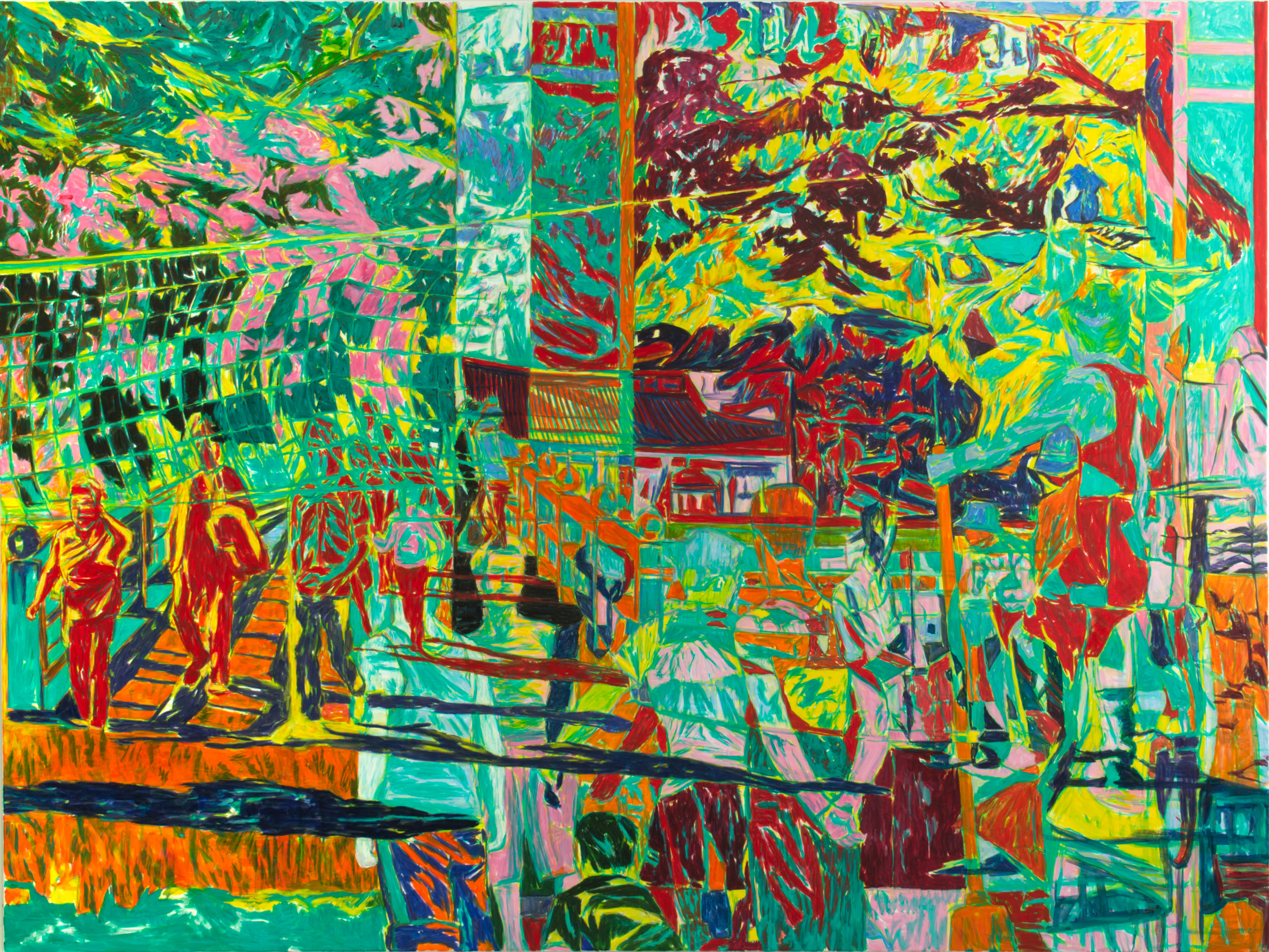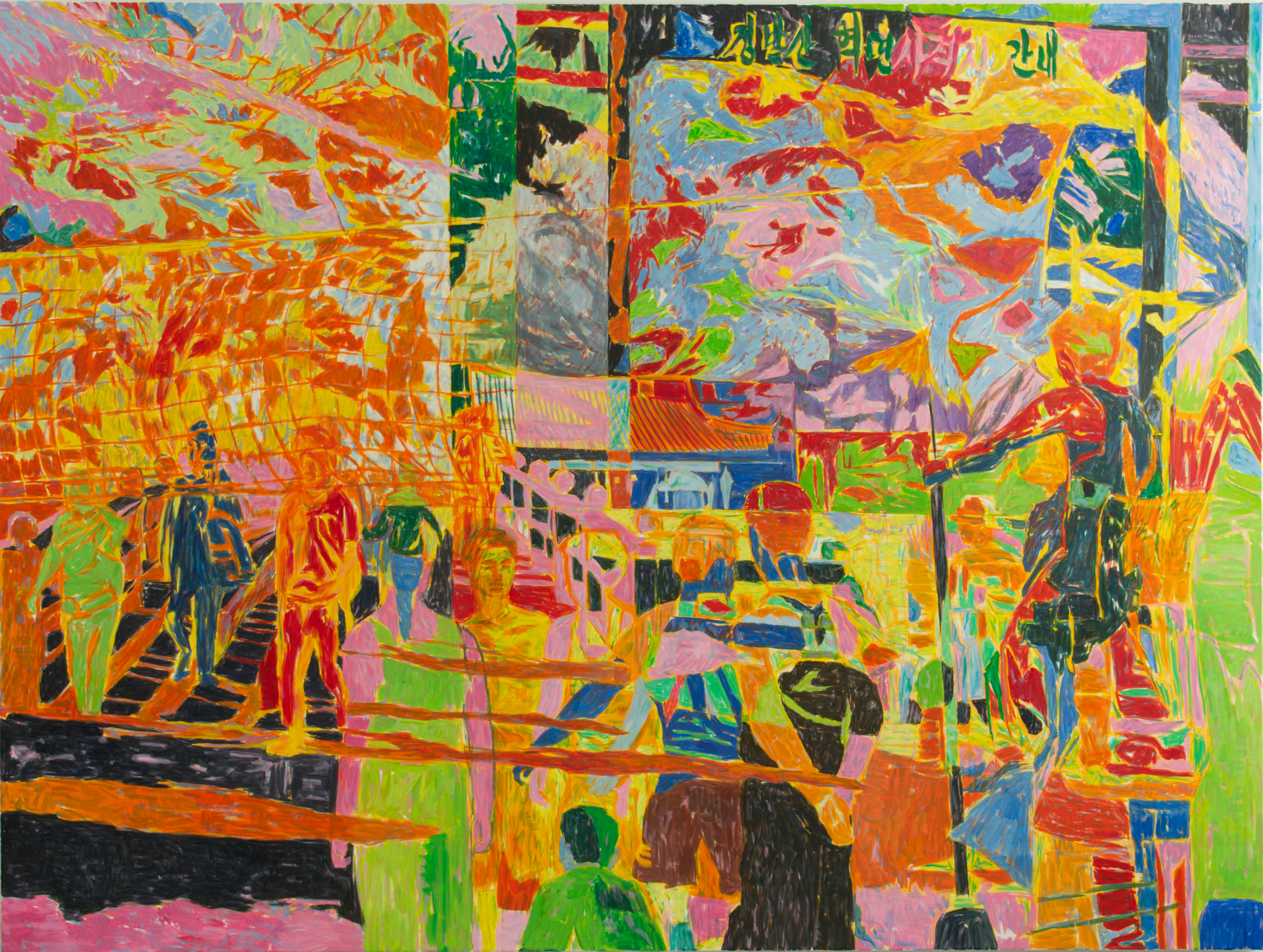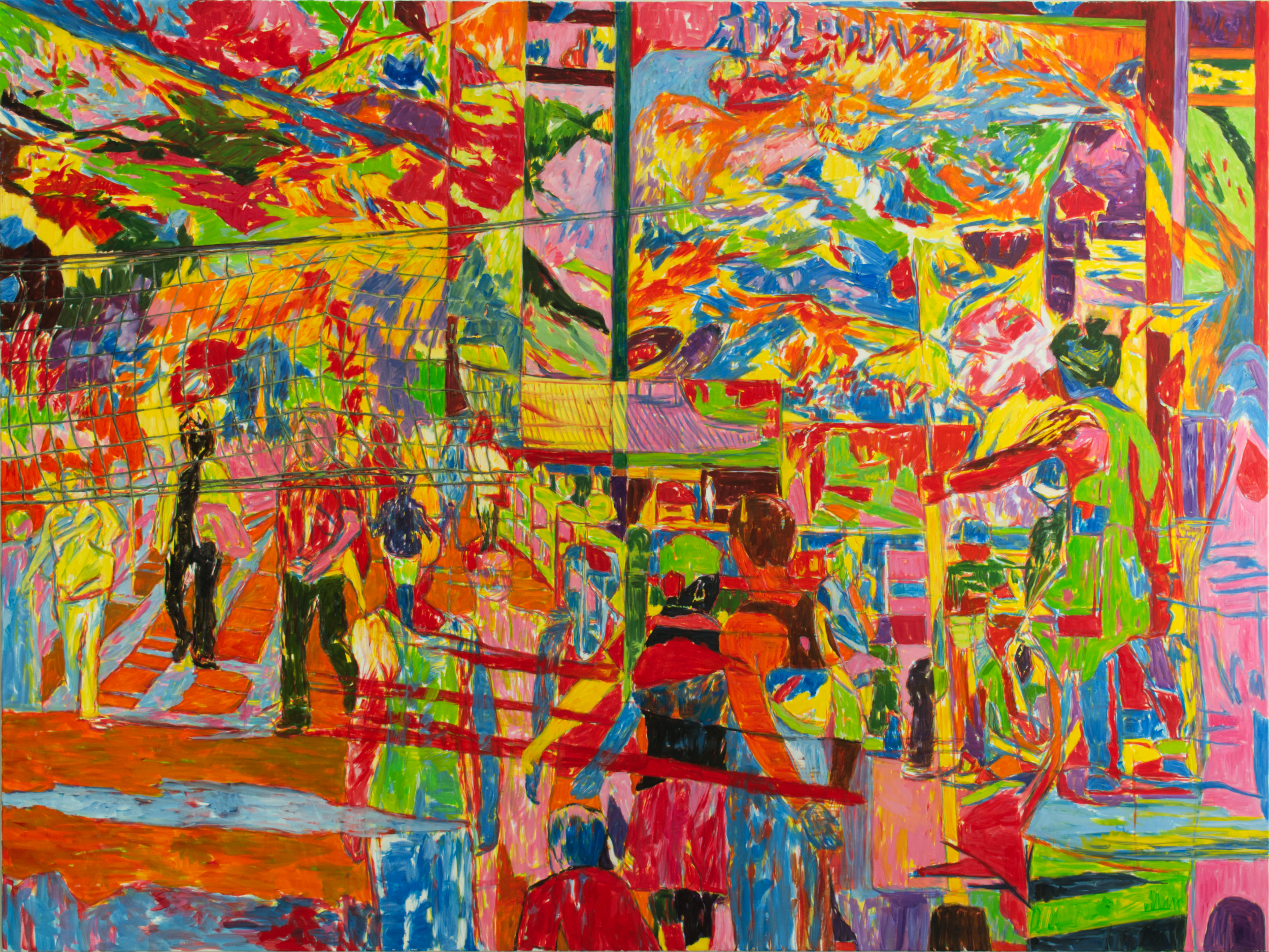



Photography: Kichun Park

Photography: Kichun Park

Photography: Kichun Park

Photography: Kichun Park

Photography: Kichun Park

Photography: Kichun Park

Photography: Kichun Park

Photography: Kichun Park

Photography: Kichun Park

Photography: Kichun Park
(De-)vision Division
(De-)vision Division is a series of paintings of a single scene that blends an everyday scenario from North Korea and another scenario from South Korea into one. It is a scene I combined from two photos, one of volleyball players in North Korea, and one of people walking on a gentle slope of a mountain in Gangwon-do, South Korea. Korea has been divided for 77 years. Although many attempts have been made to reconcile and reunify the two states (e.g., through the so called “Sunshine Politics”) the division remains as unquestionable as ever and the border is one of the most heavily monitored regions in the world.
With this series, I paint landscapes where boundaries are broken down – in the actual landscapes as well as in the painting techniques and further artistic methods I am using in the process. The paintings of (De-)vision Division are variations of the motif described above. The idea behind the repetition is to envision the two divided Korean states as unified – yet blurred and modified. Through the tearing down of borders, between the two depicted scenarios and metaphorically between the two divided states, the long-dreamt reunification or peaceful coexistence of the two Korean states becomes tangible – at least in the eyes of the viewer. As a result of this process of visually undoing the division, the famous quote about the German reunification of the former federal chancellor Willy Brandt, “What belongs together is growing together,” may be applied to my paintings.
I have finished the first ten paintings of the series between 2021 and 2023, a time during which I was working on abstracting the realistic scenes through a formal visual language, because actual boundaries can never be broken down if reproduced on canvas. Rather, it is necessary to first discover the formative features behind the visual surface of a border or boundary, to then verbalize these features in a pictorial language. While in the beginning, it was difficult to move away from a reproductive interpretation of the motifs, by the seventh painting, I began to replace the realistic elements of the scene by an abstract formal language. For example, the green of the landscape was replaced by red, and the boundaries of the landscape immediately began to blur. In order to develop this change further, I painted now till the twelves paintings.
I am planning to continue with the next 8 paintings on this series. And this year I will work on the next five paintings along with an in-depth study of my painterly elements and techniques. I intend to refine my method of translating the realistic elements of a scene into an abstract formative language, while at the same time working on connecting the abstract pictorial elements back to the realistic scene. By enriching my pictorial language and by using academic research methods for the in-depth study of my own painting techniques, the next paintings will result in a new landscape, one that pushes the idea of a new vision even further. The boundaries of the existing landscapes of the separated North and South, which are subtly overlapped – in each of the paintings – with each other, are broken down more and more with each new painting, and the two landscapes will be combined in yet a new way.
I chose the division of the Korean Peninsula as the central theme of this series because, when asked what is the most taboo and incomprehensible issue for me as a Korean, the first thing that comes to mind is this very division. This stark boundary not only creates a physical separation between the people of North and South Korea but also imposes significant limitations on their thoughts, effectively denying them the freedom of expression.
Through my work, I try to transcend this taboo and visualize a landscape where North and South coexist in a new way.
연작 <(탈)시각 분단>은 모두 동일한 모티브를 바탕으로 세로 180cm, 가로 240cm의 대형 캔버스 위에 유화로 제작된다.
(탈)시각 분단
연작 <(탈)시각 분단>은 북한의 일상 풍경과 남한의 또 다른 풍경을 하나의 장면으로 그리는 회화 연작이다. 이 연작의 모티브는 북한에서 배구하는 사람들의 모습과 남한 강원도 산의 완만한 경사면을 걷는 사람들의 모습, 두 장의 사진을 합성한 장면이다. 한국은 분단된 지 77년이 되었다. 소위 ‘햇볕정책’을 비롯해 남북 화해와 통일을 위한 많은 시도가 있었지만, 분단은 여전히 해소되지 않았고 휴전선은 세계에서 가장 감시가 심한 지역 중 하나이다.
이 연작을 통해 나는 실제 풍경뿐만 아니라 그 과정에서 사용하는 회화 기법과 예술적 방법에서 경계가 허물어진 풍경을 그린다. <(탈)시각 분단>의 그림은 위에서 설명한 모티브의 다양한 변형을 담고 있다. 이 반복의 이면에는 분단된 한국의 두 국가가 통일된 것처럼 보이지만 흐릿하고 변형된 모습으로 상상하는 아이디어가 숨어 있다. 묘사된 두 시나리오 사이, 그리고 은유적으로, 분단된 두 국가 사이의 경계가 허물어짐으로써 오랫동안 꿈꿔왔던 통일 또는 평화로운 공존이 적어도 보는 사람의 눈에는 실체화된다. 이렇게 분단을 시각적으로 해소하는 과정을 통해 빌리 브란트 전 독일 총리의 독일 통일에 대한 유명한 명언 “함께 속한 것은 함께 성장한다”가 내 그림에도 적용될 수 있을 것 같다.
나는 2021년부터 2023년까지 이 시리즈의 첫 번째 열 점의 그림을 완성했다. 캔버스에 이 풍경을 그대로 재현할 경우 실제 풍경의 경계는 허물어질 수 없다고 생각했기 때문에, 이 시기에는 회화적 조형 언어를 통해 현실적인 장면을 추상화하는 작업에 집중하였다. 형체를 이루는 시각적 요소 이면에 있는 조형적 특징을 발견하고 이를 회화적 언어로 언어화하는 것이 필요했다. 처음에는 모티브에 대한 재현적 해석에서 벗어나기 어려웠지만, 일곱 번째 그림에서는 장면의 사실적 요소가 추상적 조형 언어로 대체되기 시작했다. 예를 들어 풍경의 녹색이 빨간색으로 바뀌고 풍경의 경계가 즉시 흐려지기 시작했다. 이러한 변화를 더욱 발전시키기 위해 열두 번째 그림까지 작업하였다.
2025년까지 나는 회화적 요소와 기법에 대한 심도 있는 연구와 함께 다음의 다섯 점의 그림을 그릴 것이다. 장면의 사실적인 요소를 추상적인 조형 언어로 번역하는 방법을 지속 발전시키는 동시에 추상적인 회화적 요소를 다시 사실적인 장면으로 연결하는 작업을 할 계획이다. 다양한 드로잉을 보조로 하여 회화적 언어를 풍부하게 하고 학문적 연구 방법을 사용하여 나만의 회화 기법을 심도 있게 연구함으로써 다음 그림은 새로운 풍경, 새로운 비전에 대한 아이디어를 더욱 발전시키는 새로운 풍경이 될 것이다. 약 20개의 그림에서 서로 미묘하게 겹쳐져 있는 분단된 남과 북의 기존 풍경의 경계는 새로운 그림을 그릴 때마다 점점 더 허물어지고, 두 풍경은 또 다른 새로운 방식으로 결합될 것이다.
내가 한반도 분단을 이 시리즈의 중심 주제로 선택한 이유는 누군가 한국인으로서 가장 금기시되고 이해할 수 없는 것이 무엇이냐고 물었을 때 가장 먼저 떠오르는 주제가 바로 한반도 분단에 관련된 것 이기 때문이다. 이 명확한 경계는 남과 북의 사람들에게 물리적 공간뿐만 아니라 생각의 제한을 설정 하고, 자연스럽게 발언의 자유를 부정한다.
내 작업을 통해 나는 이 금기를 넘어서서, 남, 북이 새롭게 공존하는 풍경을 시각화하려 한다.